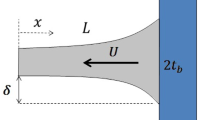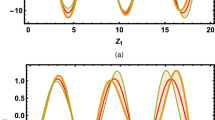Abstract
In this article, we propose a modified FxLMS (Filtered least mean square algorithm) fluid flow control model of a linear convectively unstable disturbance over a flat plate in one dimensional sense. In many flow situations, we need to suppress the flow instabilities as it causes unnecessary drag and noise due to enhancement of perturbation amplitude, whereas in few other flow situations, we deliberately need the flow perturbations in an enhanced desired permissible set level to obtain a desired mixing or controlled enhancement of heat transfer through the fluids. We propose a one dimensional modified FxLMS flow control model through which we can achieve controlled attenuation as well as enhancement in the amplitude of fluid perturbation with single additional gain in the control model. This method is widely used in noise control and signal processing areas. We adopt the similar modeling approach to confront the problem. One dimensional linearized Kuramoto–Sivashinsky equation model (KS equation) is used to model the fluid flow. We make use of model-free adaptive method to further apply it for fluids flows. A structurally modified adaptive algorithm incorporating FxLMS is designed and tested to get the desired set level of fluctuations in the fluid flow. In this control model, with a set value of additional gain, we achieve cancellation, attenuation, enhancement, and neutralization of perturbation amplitude downstream of the fluid flow in one dimensional sense. With the fast Fourier transformation (FFT) analysis, we have also observed that, the modified FxLMS fluid flow adaptive control model attenuates/enhances the set of troubling frequencies accordingly.
















Similar content being viewed by others
References
Landahl M T 1980 A note on an algebraic instability of inviscid parallel shear flows. J. Fluid Mech., 98(2): 243–251
Morkovin M V 1985 Bypass transition to turbulence and research desiderata
Gad-el Hak M 2007 Flow control: passive, active, and reactive flow management. Cambridge University Press
Akhtar M T, Abe M and Kawamata M 2006 A new variable step size lms algorithm-based method for improved online secondary path modeling in active noise control systems. IEEE Trans. Audio Speech Lang. Process., 14(2): 720–726
Akhtar M T and Mitsuhashi W 2009 Improving performance of fxlms algorithm for active noise control of impulsive noise. J. Sound Vib., 327(3-5): 647–656
Fabbiane N 2016 Transition delay in boundary-layer flows via reactive control. PhD thesis, KTH Royal Institute of Technology
Kim J 2003 Control of turbulent boundary layers. Phys. Fluids, 15(5): 1093–1105
Chang Y and Scott Collis S 1999 Active control of turbulent channel flows based on large eddy simulation. ASME Paper No. FEDSM-99, 6929: 1–8
Temam R, Bewley T and Moin P 1999 Control of turbulent flows. CHAPMAN AND HALL CRC RESEARCH NOTES IN MATHEMATICS, pages 3–11
Crook A 2002 The control of turbulent flows using synthetic jets. PhD thesis, University of Manchester: University of Manchester
Jacobi A M and Shah R K 1995 Heat transfer surface enhancement through the use of longitudinal vortices: a review of recent progress. Exp. Therm. Fluid Sci., 11(3): 295–309
Aamo O M, Krstić M and Bewley T R 2003 Control of mixing by boundary feedback in 2d channel flow. Automatica, 39(9): 1597–1606
Schlichting H and Gersten K 2000 Boundary layer theory. Springer-verlag, Berlin, Heidelberg
Schmid P J and Henningson D S 2001 Stability and transition in shear flows. number v. 142 in applied mathematical sciences
Bagheri S and Henningson D S 2011 Transition delay using control theory. Philos. Trans. R. Soc. Lond. A Math. Phys. Eng. Sci., 369: 1365–1381
Semeraro O, Bagheri S, Brandt L and Henningson D S 2013 Transition delay in a boundary layer flow using active control. J. Fluid Mech., 731: 288–311
Semeraro O, Pralits J O, Rowley C W and Henningson D S 2013 Riccati-less approach for optimal control and estimation: an application to two-dimensional boundary layers. J. Fluid Mech., 731: 394–417
Carini M, Pralits J O and Luchini P 2015 Feedback control of vortex shedding using a full-order optimal compensator. J. Fluids Struct., 53: 15–25
Thomas Bewley, Paolo Luchini and Jan Pralits 2016 Methods for solution of large optimal control problems that bypass open-loop model reduction. Meccanica, 51: 2997–3014
Simon B, Markus D, Tropea C and Grundmann S 2018 Cancellation of Tollmien–Schlichting waves in direct vicinity of a plasma actuator. AIAA J., 56, 1760–1769
Kotsonis M, Giepman R, Hulshoff S and Veldhuis L 2013 Numerical study of the control of Tollmien–Schlichting waves using plasma actuators. AIAA J., 51: 2353–2364
Lundell F 2007 Reactive control of transition induced by free-stream turbulence: an experimental demonstration. J. Fluid Mech., 585: 41–71
Tol H J, de Visser C C and Kotsonis M 2019 Experimental model-based estimation and control of natural Tollmien–Schlichting waves. AIAA J., 57: 2344–2355
Vemuri S H S, Bosworth R, Morrison J F and Kerrigan E C 2018 Real-time feedback control of three-dimensional Tollmien–Schlichting waves using a dual-slot actuator geometry. Phys. Rev. Fluids, 3: 053903
Simon B, Nemitz T, Rohlfing J, Fischer F, Mayer D and Grundmann S 2015 Active flow control of laminar boundary layers for variable flow conditions. Int. J. Heat Fluid Flow, 56: 344–354
Kurz A, Grundmann S, Tropea C, Forte M, Seraudie A, Vermeersch O, Arnal D, Goldin R and King R 2013 Boundary layer transition control using dbd plasma actuators. AerospaceLab, pages p-1
Kurz A, Simon B, Tropea C and Grundmann S 2014 Active wave cancelation using plasma actuators in flight. In: 52th AIAA Aerospace Sciences Meeting
Sturzebecher D and Nitsche W 2003 Active cancellation of Tollmien–Schlichting instabilities on a wing using multi-channel sensor actuator systems. Int. J. Heat Fluid Flow, 24(4): 572–583
Grundmann S and Tropea C 2007 Experimental transition delay using glow-discharge plasma actuators. Exp. Fluids, 42: 653–657
Gurun A and White E 2005 Tollmien–Schlichting wave suppression and transition delay using stationary transient disturbances. In: 4th AIAA Theoretical Fluid Mechanics Meeting, page 5313
Amitay M, Tuna B A and Dell’Orso H 2016 Identification and mitigation of ts waves using localized dynamic surface modification. Phys. Fluids, 28: 064103
Hanson R E, Lavoie P, Naguib A M and Morrison J F 2010 Transient growth instability cancelation by a plasma actuator array. Exp. Fluids, 49: 1339–1348
Jacobson S A and Reynolds W C 1998 Active control of streamwise vortices and streaks in boundary layers. J. Fluid Mech., 360: 179–211
Elliott S J and Nelson P A 1993 Active noise control. IEEE Signal Process. Mag., 10: 12–35
Kuo S M, Ji M J and Jiang X H 1993 Development and experiment of narrowband active noise equalizer. Noise Control Eng. J., 41: 281–288
De Oliveira L P R, Stallaert B, Janssens K, Van der Auweraer H, Sas P and Desmet W 2010 Nex-lms: A novel adaptive control scheme for harmonic sound quality control. Mech. Syst. Signal Process., 24: 1727–1738
Rees L E and Elliott S J 2006 Adaptive algorithms for active sound-profiling. IEEE Trans. Audio Speech Lang. Process., 14: 711–719
Sivashinsky G I 1977 Nonlinear analysis of hydrodynamic instability in laminar flames-i derivation of basic equations. Acta Astronautica, 4: 1177–1206
Sivashinsky G I 1977 Diffusional-thermal theory of cellular flames. Combust. Sci. Technol., 15(3-4): 137–145
Sivashinsky G I 1983 Instabilities, pattern formation, and turbulence in flames. Annu. Rev. Fluid Mech., 15: 179–199
Manneville P 1995 Dissipative structures and weak turbulence. In: Chaos-The Interplay Between Stochastic and Deterministic Behaviour, Springer, pp 257–272
Kuramoto Y and Tsuzuki T 1976 Persistent propagation of concentration waves in dissipative media far from thermal equilibrium. Prog. Theor. Phys., 55: 356–369
Fabbiane N, Semeraro O, Bagheri S and Henningson D S 2014 Adaptive and model-based control theory applied to convectively unstable flows. Appl. Mech. Rev., 66(6): 060801
Glad T and Ljung L 2000 Control theory. CRC Press
Nordström J, Nordin N and Henningson D 1999 The fringe region technique and the Fourier method used in the direct numerical simulation of spatially evolving viscous flows. SIAM J. Sci. Comput., 20: 1365–1393
Fabbiane N, Simon B, Fischer F, Grundmann S, Bagheri S and Henningson D S 2015 On the role of adaptivity for robust laminar flow control. J. Fluid Mech., 767: R1–R12
Fabbiane N, Bagheri S, and Henningson D S 2017 Energy efficiency and performance limitations of linear adaptive control for transition delay. J. Fluid Mech., 810: 60–81
MATLAB 2020 version 9.8 (R2020b) The MathWorks Inc., Natick, Massachusetts
Åström K J and Wittenmark B 2013 Adaptive control. Courier Corporation
Acknowledgements
We acknowledge that we have modified the existing MATLAB source code written by N.Fabbiane [43] presented at url - https://www.mech.kth.se/~nicolo/ks/. And our MATLAB codes for modified FxLMS algorithm can be downloaded from url - https://github.com/ravikgpiit/Modified-FxLMS.
Author information
Authors and Affiliations
Corresponding author
Ethics declarations
Conflicts of interest
On behalf of all authors, the corresponding author states that there is no conflict of interest. The authors have NO affiliations with or involvement in any organization or entity with any financial interest, or non-financial interest in the subject matter or materials discussed in this manuscript.
Rights and permissions
About this article
Cite this article
Kant, R., Vinod, N. A modified FxLMS fluid flow control model for convectively unstable disturbances. Sādhanā 47, 104 (2022). https://doi.org/10.1007/s12046-022-01874-7
Received:
Revised:
Accepted:
Published:
DOI: https://doi.org/10.1007/s12046-022-01874-7




